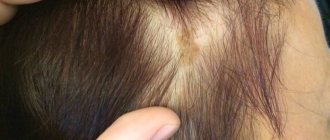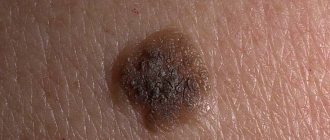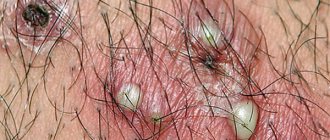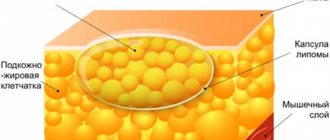Dermatovenerologist
Khasanova
Alina Rashidovna
7 years experience
Make an appointment
A mole is a benign formation that appears on the skin. Its key feature is pronounced pigmentation against the general background of the skin.
These pigments begin to appear at an early age. Children and adults have them. On the one hand, their presence does not cause any concern. On the other hand, moles from a benign formation can “grow” into a malignant one. Therefore, at the first signs of changes and severe symptoms, you should consult a specialist.
In professional medicine, a mole has another name - nevus. In general, this is not a strict medical concept; the word is used to unite various neoplasms that differ in nature.
Symptoms and signs of moles in adults
In medical practice, sometimes dangerous moles come across that need to be quickly removed. If this is not done, the disease will begin to progress, which can lead to quite unpleasant consequences. Therefore, it is extremely important to monitor the condition of pigmentation on the skin. Especially if you have large moles on your body or those that have begun to grow and visually change.
The symptoms of “bad” moles are as follows:
- moles of a different shape appear, symmetry is lost, the neoplasm grows in one direction;
- the edges become “torn”;
- Over time, the color changes and becomes uneven. This is the first sign that malignant moles are appearing on the body;
- quick resizing;
- change in texture - smooth moles become rough and vice versa;
- if there are hairs on the surface, their sudden loss should cause a person to worry;
- peeling, itching and burning in the place where the mole is.
Diagnosis of a white mole
At the first examination, the doctor assesses the localization of the tumor, its age, and its depth. Armed with a dermatoscope, he studies the structure of the mole in detail. It is possible to study the condition of the nevus in layers. It is implemented using a special computer program. If any fluid is released from the mole, scraping is performed. The biological material obtained in this way is sent for microscopy. With its help, specialists are able to identify bacterial or fungal skin lesions.
If cancer is suspected, a biopsy is performed followed by histological examination.
Causes
Why do moles appear on the skin? Every experienced mole doctor will say that there are several reasons for their appearance on the body:
- ultraviolet radiation;
- traumatic damage to the epidermis;
- systematic violation of the integrity of the skin;
- negative influence of radioactive background;
- Constant consumption of unhealthy foods, smoking, drinking alcoholic beverages. Because of this, moles on the body constantly grow;
- problems in the functioning of the endocrine system, changes in hormonal levels;
- hereditary predisposition.
Treatment of white nevi
It is impossible to treat the described formations with drug therapy. If a mole grows in a place where it is not subject to friction from clothing, it can be left alone: a white mole does not pose a direct danger. A threat to life arises only if complications develop. If the nevus is constantly injured, it is better to remove it immediately. There are many techniques that allow you to do this in a hospital setting. Each has its own pros and cons.
| Method name | The essence of the procedure | Existing indications | Advantages | Flaws |
| Traditional surgery | White moles are removed using a scalpel. | Ideal for getting rid of large moles | In one procedure, the doctor is able to remove a nevus of any size. The operation is performed in a surgical hospital, where strict control over the patient's condition is ensured. The hospital has all the facilities to provide emergency care. Surgical removal of a mole allows you to obtain tissue, which can then be sent for histology and make sure that there are no processes of malignancy. Due to the fact that all nevus cells are removed, the possibility of relapse is completely excluded | After removing a large mole, stitches are placed on the wound. When they heal, a keloid scar remains on the skin. It is very difficult to dissolve. For this reason, this method of mole removal is never used if nevi grow on the face or other open areas of the body. After the operation is completed, a long recovery period begins. To prevent the development of a bacterial infection, a course of antibiotic therapy is required. This is an extra burden on the body |
| Electrocoagulation | Removal of moles by exposing them to direct or high-frequency electric current. It is used to coagulate (cauterize) the selected area. | Ideal for removing the smallest tumors and nevi with a small base | One session lasts several minutes. The operation is performed using a special attachment, which allows you to control the depth of penetration of the electric current. This helps prevent damage to nearby healthy tissue. Due to coagulation of small vessels, there is no risk of bleeding. During cauterization, the wound is disinfected, and this, in turn, helps prevent infection of the surgical field | The procedure is very painful, so it is performed under local anesthesia. After surgery, rehabilitation is required, which is similar to the treatment of burns. If the surgical area is large, there are risks of scar tissue formation. If moles are removed layer by layer, wound healing occurs in the same way as after surgery |
| Cryodestruction | Moles are removed using liquid nitrogen. Its temperature can reach up to 190 degrees. Under the influence of such indicators, the water in the nevus cells freezes, and ice crystals destroy the neoplasm cells. Complete death of the affected tissue occurs | Ideal for removing several white moles at once | The procedure for using liquid nitrogen is completely painless. One session lasts only ten minutes. During this time, several nevi can be treated at once | During the removal of a white mole, its tissue is completely destroyed, so histological examination becomes impossible. This may cause melanoma to be missed. Even using special devices, the doctor is not able to control the depth of penetration of cold. Therefore, there is always a risk of damage to healthy tissue. For the same reason, relapses become possible. |
| Laser removal | The operation is performed using an installation that reproduces a carbon dioxide laser. When it acts, it creates heat, which evaporates the moisture contained in the cells of the mole. As a result, it is destroyed. | Ideal for removing one small nevus | The operation is painless. She has practically no contraindications. As a result of the use of laser therapy, it is possible to obtain a lasting result that eliminates the risk of relapse. The recovery period is only three days | The results of the operation directly depend on the qualifications and experience of the doctor. It may take several sessions to remove a medium-sized mole. During the operation, layer-by-layer evaporation of pathological tissue occurs. This does not allow obtaining biological material for subsequent histological examination. |
| Radio wave surgery | Tissue separation is carried out using a knife-like attachment that generates high-frequency waves. Their influence accelerates the movement of water molecules, as a result of which the liquid boils and evaporates. This ensures coagulation of blood vessels, prevents the development of bleeding, cauterizes nerve endings, which leads to a reduction in pain, and sterilizes surrounding tissues. As a result, the risks of wound infection are reduced to zero. The doctor has the ability to control the depth of penetration | Ideal for removing white moles growing on the face, neck, ears, eyelids | On average, one session lasts twenty minutes. After the operation there are no complications at all, the risk of infection is eliminated, the healthy surrounding tissues are completely preserved, and after the operation the wound does not require additional treatment. The patient can immediately return to his normal life. The method is considered bloodless, its use allows obtaining biological material for histology | When removing a large white mole, a scar may form. The cost of the described operation is much more expensive than the methods listed above for removing nevi |
When to see a doctor
There are the following types of moles:
- pigmented;
- vascular.
Usually, red moles on the body are harmless, but only if they have not changed color. If you find a mole, what should you do in this case? First, we advise you to carefully examine it. You need to go to the clinic with a mole if you have:
- bleeding or peeling;
- itching;
- dark areola or rim;
- rapid increase in size;
- sudden color change.
Classification of nevi
To facilitate diagnosis, all nevi are divided into several groups. Their description is presented in the following table.
| Diagnostic criteria | Their manifestations |
| External data | Warty, convex, flat |
| Dimensions | Small, medium, large, huge |
| Color | Brown, red, white |
If a patient has a raised white mole of small or medium size, he does not need to worry. If you have a huge discolored nevus hanging over the skin, this is a reason to make an appointment with a dermatologist.
Reasons for the appearance of nevi on the face
It has been noticed that new moles appear more often in the face area. What explains this?
- Firstly, the skin on the face is delicate and thin in structure, it quickly reacts to the influence of external and internal irritants;
- Secondly, a large amount of melanin, which is contained in skin cells, accumulates in the facial area. And, as you know, pigmented nevi are formed precisely from these melanin cells.
The reasons that can cause the appearance of pigmented moles on the face and activate the growth of melanin cells have been studied quite well. The most common ones include the following:
- Genetic factor. This is one of the most popular reasons that explains the appearance of moles on the face. The number of birthmarks depends on whether there are such neoplasms in the family. It has been noticed that some “signs of fate” are passed on from generation to generation. There are even cases where a mole appeared in the same place and was the same shape and color for several generations in a family. This pattern is especially noticeable in those who have a mole located on their face. Thus, genetic predisposition to moles is considered a very important reason that explains the appearance and number of nevi in humans;
- The influence of solar radiation. Each of us has areas on our skin where melanin accumulates - that is, the sites of future moles. They are not noticeable until they are influenced by certain factors, one of which is ultraviolet radiation. It has been noticed that new nevi often appear on the face. It’s quite simple to explain: the face most often remains open. And if in the summer we still try to somehow protect it from ultraviolet radiation by applying protective cream to our face or purchasing a hat with a brim or a visor, then in the cold season we do not pay as much attention to means of protecting our face from the sun. But in vain! Winter or earlier spring sun is no less dangerous for the skin than summer sun. Therefore, you should start using protective creams at the end of winter. This will help avoid the appearance of new pigmented tumors that are “hidden” and waiting for their time;
- Hormonal surges in the body. According to statistics, women have more moles on their faces than men. This can be explained by the fact that the female body experiences more hormonal changes during its life than the male body. Factors that can cause the appearance of new birthmarks on the face of women include pregnancy, gynecological diseases, menopause - that is, all those reasons that disrupt the hormonal balance. You may notice how a new mole appears when taking contraceptive medications that affect hormone levels;
- Injuries and infections. Many doctors, despite the fact that this has not been scientifically proven, claim that new birthmarks may appear on the face and other parts of the body if the skin has been injured, has been exposed to frequent x-rays, or has been infected. How accurate this is is unknown, but this factor should not be excluded.
Complications
The most serious complication of a white mole is malignancy, that is, the transition of a benign pathological process to a malignant one. It is worth noting that the frequency of malignancy of white nevi is minimal, but everything happens.
On this topic
- Moles
All about how to care for a removed mole
- Irina Nasredinovna Nachoeva
- August 19, 2020
People who are at risk and have:
- congenital mole of significant size;
- a mole that appeared after 60 years;
- any mole with a diameter of 3 cm or more;
- number on the body .
Frequent injuries and rubbing of moles can provoke degeneration into cancer. In this case, it is worth paying attention to the frequency of the appearance of new nevi, bleeding and the appearance of crusts on their surface.
If you experience discomfort, pain or itching in the area of the mole, do not delay visiting a doctor. After all, the sooner treatment is carried out, the more favorable the outcome.
Symptoms
Birthmarks are white in color, significantly different from ordinary ones, and have the following characteristics:
- softer surface
- the color of the mole is lighter in contrast to the surrounding skin,
- the boundaries are clear and even,
- the edges of the formation itself are not inflamed.
A convex white mole, in appearance, resembles an ordinary flat wart. Such formations can be single or multiple.
The size of such birthmarks can range from 3 mm to 20 mm. Inside the formation there is a capillary network, or small brown dots. White moles are most often localized on the neck, under the arms, chest and on the external genitalia. Less common, but they occur on the stomach and limbs.
In children, such formations appear either from birth or from the age of three months. Usually they have a benign prognosis and are not at all dangerous for the baby. Congenital moles can increase in size as the body grows. If there are no other signs, then this is normal and does not require treatment.
White birthmarks are usually not dangerous











